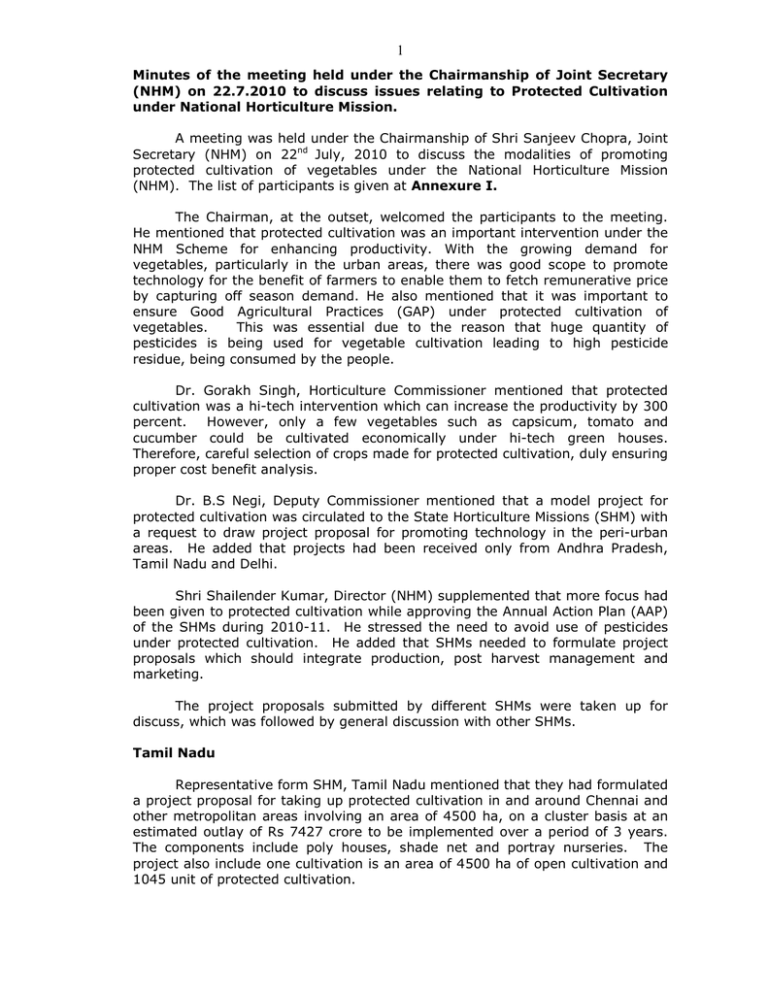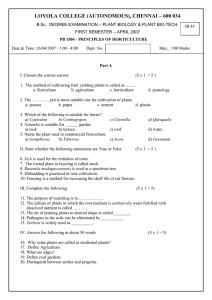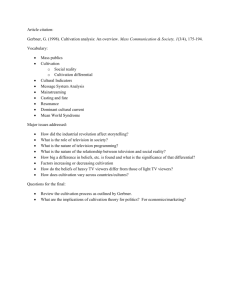Minutes.... - National Horticulture Mission
advertisement

1 Minutes of the meeting held under the Chairmanship of Joint Secretary (NHM) on 22.7.2010 to discuss issues relating to Protected Cultivation under National Horticulture Mission. A meeting was held under the Chairmanship of Shri Sanjeev Chopra, Joint Secretary (NHM) on 22nd July, 2010 to discuss the modalities of promoting protected cultivation of vegetables under the National Horticulture Mission (NHM). The list of participants is given at Annexure I. The Chairman, at the outset, welcomed the participants to the meeting. He mentioned that protected cultivation was an important intervention under the NHM Scheme for enhancing productivity. With the growing demand for vegetables, particularly in the urban areas, there was good scope to promote technology for the benefit of farmers to enable them to fetch remunerative price by capturing off season demand. He also mentioned that it was important to ensure Good Agricultural Practices (GAP) under protected cultivation of vegetables. This was essential due to the reason that huge quantity of pesticides is being used for vegetable cultivation leading to high pesticide residue, being consumed by the people. Dr. Gorakh Singh, Horticulture Commissioner mentioned that protected cultivation was a hi-tech intervention which can increase the productivity by 300 percent. However, only a few vegetables such as capsicum, tomato and cucumber could be cultivated economically under hi-tech green houses. Therefore, careful selection of crops made for protected cultivation, duly ensuring proper cost benefit analysis. Dr. B.S Negi, Deputy Commissioner mentioned that a model project for protected cultivation was circulated to the State Horticulture Missions (SHM) with a request to draw project proposal for promoting technology in the peri-urban areas. He added that projects had been received only from Andhra Pradesh, Tamil Nadu and Delhi. Shri Shailender Kumar, Director (NHM) supplemented that more focus had been given to protected cultivation while approving the Annual Action Plan (AAP) of the SHMs during 2010-11. He stressed the need to avoid use of pesticides under protected cultivation. He added that SHMs needed to formulate project proposals which should integrate production, post harvest management and marketing. The project proposals submitted by different SHMs were taken up for discuss, which was followed by general discussion with other SHMs. Tamil Nadu Representative form SHM, Tamil Nadu mentioned that they had formulated a project proposal for taking up protected cultivation in and around Chennai and other metropolitan areas involving an area of 4500 ha, on a cluster basis at an estimated outlay of Rs 7427 crore to be implemented over a period of 3 years. The components include poly houses, shade net and portray nurseries. The project also include one cultivation is an area of 4500 ha of open cultivation and 1045 unit of protected cultivation. 2 It was pointed out to SHM, Tamil Nadu that since open cultivation of vegetable was not covered under NHM, the project had to be revised to include only protected cultivation of vegetables. Delhi Shri D.K. Thakur, Joint Director of Agriculture, NCT of Delhi mentioned that they had submitted a project proposal for cultivation of vegetables which involved protected cultivation also. It was however, pointed out that protected cultivation was a minor component of project and major component was open cultivation of vegetables. Comments had been sent to Delhi Administration. Shri Thakur mentioned that they were facing problem in getting State share of outlay which was hindering the implementation. JS (NHM) mentioned that matter would be taken up with the Development Commissioner, Govt. of Delhi to resolve the issue. Andhra Pradesh Shri D.B. Naik, Executive Director, SHM, Andhra Pradesh mentioned that it was proposed to promote protected cultivation of vegetables in four districts around Hyderabad. Fifteen clusters of 10 acres each had been identified. Each beneficiary had half acre under protected cultivation and another half acre under open cultivation of vegetables. A cluster of 10 acres would have one poly house, to be managed by a progressive farmer. SHM was informed that project had to be revised to cover only activities of protected cultivation. Gujarat Shri C.M. Patel, Joint Director of Horticulture, Gujarat mentioned that Gujarat had given focus on the protected cultivation and about 100 acre land had been covered under protected cultivation with an investment of Rs 15 crore. He suggested the need for increasing the ceiling from 1000 sqm to 2000 sqm. On enquiry about the cost norms, he mentioned that the old NHM norms were presently being followed under the State scheme, which were to be brought at par with the new NHM norms. He added that a provision of Rs.659 lakh has been earmarked for protected cultivation in the State during 2010-11, which needed to be enhanced. Proposal in this regard was being sent by the SHM. The Chairman requested Shri Patel to send a copy of the State Scheme on Protected Cultivation for circulation to other States. Haryana Representative from SHM, Haryana mentioned that protected cultivation was being promoted under the Indo-Israel project. During 2010-11, an outlay of Rs. 700 lakh had been earmarked for protected cultivation including Rs. 300 lakh for Green Houses, Rs. 125 lakh for Shade net Houses and Rs. 200 lakh for low tunnels. Protected cultivation was mainly being under taken in Morani Hills of the State. He requested for the inclusion of ‘walk-in-tunnels’, which were being used extensively in Israel and also in Haryana. Horticulture Commissioner clarified that ‘walk-in-tunnels’ were also green-houses, with less height and could be 3 taken up under NHM. Cost norms had, however, vary depending on the size, when compared to normal green house. Punjab Shri L.S Brar, Director of Horticulture, Punjab informed that different types of protected cultivation were being promoted in the State. So far, 8 units of fan pad types of green house, 62 units of naturally ventilated, 25 normal green house and 75 units of low tunnels had been constructed. It was proposed to take up 49 units of Hi-tech, 13 units of normal and 6000 units of low tunnels during 2010-11 under NHM. 500 units of Shade net houses had been taken up under RKVY of which 200 had been completed. Tie up had been made with Punjab Agro Industrial Corporation (PAIC) for PHM and marketing. PAIC had made 10 Integrated Pack Houses. Facilities had been created at Perishable Cargo centre at Amritsar Airport for promoting export of vegetables He requested the need to enhance the ceiling of green house from 1000 Sq. m to 3000 sq. m. When it was pointed out that greenhouses of more than 1000 sqm were being funded by NHB, he mentioned that the farmers of Punjab were not interested in availing assistance from NHB as it involved borrowing from Financial Institutions. He was requested to submit a final proposal from the State Government in this regard. Kerala Dr. K. Prathapan, Mission Director, SHM Kerala informed that a provision of Rs. 99.80 lakh had been made in AAP 2010-11 for protected cultivation. It was proposed to promote protected cultivation in the adjoining areas of Cochin International Airport Ltd (CIAL) where a Centre for Perishable Cargo had been established. Presently, produce was coming from Pollachi area of Tamil Nadu. It was also proposed to introduce GAP for capturing the International market. Rajasthan Director of Horticulture, Rajasthan mentioned that special efforts were being made by the State Government to promote protected cultivation. There was a good demand for cultivating Dutch roses and gerbera under green house. So far 181 units of Green Houses 1000 sqm had been constructed in Alwar, Jaipur, Sawai Madhopur, and Kota districts. Shade net houses were being promoted under RKVY. On enquiry about the progress of Indo-Israel project, Shri Sita Ram Jat, Deputy Director of Horticulture, mentioned that experts form Israel had visited Rajasthan recently and the project proposal had been finalized. The same had been forwarded to the Israeli Embassy. He further added that Technology Innovation Centre had been established in the State with the assistance from Government of Netherlands, which was being used for training purpose. Farmers and entrepreneurs from other States could also avail the facility. He requested the need to enhance the ceiling of cost of cultivation from 500 sqm per beneficiary to the same level as assistance for greenhouse structure. He also added that green house of more than 1000 sqm were being promoted in the State under RKVY. 4 Maharashtra Shri A.K. Haral, MD, MSHMPB mentioned that protected cultivation was a popular programme in the State. The cost of shade net house had been worked out @ Rs. 270 sqm, to Rs. 360 sqm which was promoted as a credit linked activity under the innovative component of the NHM Scheme. Most of the farmers were availing the model @ Rs. 270 sqm. So far, 365 units had been constructed at a cost of Rs. 408 lakh. Provision of Rs. 1342.00 lakh had been kept for protected cultivation under NHM during 2010-11. The Horticulture Training Institute, Pune was being involved for organizing training programme for farmers who were interested in protected cultivation. Uttar Pradesh Shri S.P. Joshi, Joint Director of Horticulture, Uttar Pradesh mentioned that different types of protected cultivation were being promoted in the State under NHM and RKVY, particularly in and around Lucknow. So far, 133 Green Houses 1000 sqm had been constructed for cultivation of flowers & vegetables. NBRI Technology was being adopted by the State. Low tunnels were being used to develop seedlings of vegetables for early planting for capturing the off season market. The main vegetable crops were capsicum, tomato and cucumber, which were grown under naturally ventilated green houses. An EOI was floated recently for which good response had been received for taking up protected cultivation. He added that there was a need to increase the ceiling from 1000 sqm per beneficiaries to 2000 sqm for Green Houses. Madhya Pradesh Shri Anil Kharhe, Deputy Director of Horticulture, Madhya Pradesh mentioned that the State was promoting protected cultivation for growing vegetables like capsicum in and around Bhopal. He mentioned he case of a farmer who was growing capsicum from Green Houses of 15000 sqm which was directly sent to Dubai. The farmers now coming forward to adopt the protected cultivation. So far, Green Houses of 6500 sqm have been constructed. They are planning to organize a workshop in September, 2010 to generate awareness about the protected cultivation. He was requested to send a case study on these farmers for inclusion in the next issue of NHM Newsletter. Jharkhand Dr. Prabhakar Singh, Mission Director, Jharkhand mentioned that protected cultivation involved high technology. The State had made a limited progress in adopting this technology. During 2010-11, they proposed to construct some green houses of 1.5 ha area of the State in the Agriculture University. It was, however, clarified that the assistance was purely meant for farmers who need to be encouraged to take up ventures in protected cultivation. SHM was again taking up this activity on the land of SAU. Karnataka Shri Jayprakash, Executive Director, SHM, Karnataka stated that green house cultivation of roses was initiated in Karnataka 30 years back for flower cultivation. However, from last 10-15 years there was a good demand for green 5 houses for cultivation of vegetables. So far, 3700 Green Houses had been constructed under NHM. During 2010-11, a provision of Rs. 680 lakh had been earmarked for protected cultivation under NHM. Orissa Shri Nutan Dash, Project Officer, SHM Orissa mentioned that they had achieved limited success in protected cultivation. During the current year they proposed to promote the technology in some of the Tribal districts. The provision of Rs 47-38 lakh had been kept in the AAP 2010-11 for protected cultivation. It was pointed out that the technology needed to be promoted where there were good market linkages. Shri Krish Iyengar, JS, NCPAH mentioned that the NCPAH had been providing technical inputs about the design and cost specification of protected cultivation. Cost of cultivation had been worked out for different fruits and vegetables, which could be shared with the States. The Chairman, while conducting discussions, mentioned that he had spoken to the Managing Director of Mother Dairy, about the possibility of buy back arrangement of the vegetables being produced under ‘protected cover’. The Mother Dairy will be providing a list of location and beneficiary groups, who could be motivated to take up protected cultivation of vegetables. He suggested that the matter should be taken up with NABARD for providing credit to the farmers for protected cultivation with interest rates at par with short term loans for agriculture. He further sought the cooperation of all the Mission Directors of SHMs in carrying forward the goals and objectives of the NHM Scheme for the benefit of the farming community. The main decision points which emerged from the discussion are summarized below:1. SHMs of Andhra Pradesh, Tamil Nadu and Delhi will revise the project proposals. Other SHMs will firm up their project proposal for taking up protected cultivation of vegetables as per provision made in the AAP 201011. 2. Issues regarding enhancement of area ceiling under green house and cost of cultivation will be revised for which specific request will be made by the SHMs. 3. The SHMs will make efforts to tie up, with some of the leading retail chains like SAFAL (Mother Dairy), Godrej Aadhar, ITC Chaupal Fresh, Haryali Kissan Bazaar, Bharati Retail, Trinelhra, Adani Fresh etc., who are involved in retail marketing of vegetables. A brief write up about the major players in Fruit & Vegetables Retailing in India is given at Annexure-II. 4. SHM, Gujarat will provide a copy of their Notification about the State Scheme on Protected Cultivation, which will be circulated to other SHMs for consideration and replication. 5. NABARD will be requested to provide credit for hi-tech horticulture venture like protected cultivation on interest rates at par with short term agricultural loans. The meeting ended with a vote of thanks to the Chair. 1 Annexure- I List of Participants of meeting on regarding protected cultivation at New Delhi on 22nd July, 2010. Sl. No. A. 1. 2. 3. 4. 5. 6. 7. 8. 9. 10. 11. 12. B. 13. 14. 15. 16. 17. 18. Name & Designation GOI Shri Sanjeev Chopra, Joint Secretary & Mission Director(NHM) Dr. Gorakh Singh, Horticulture Commissioner Shri Shailender Kumar, Director (NHM) Shri Om Prakash, Additional Commissioner (NHM) Dr. B.S. Negi, Deputy Commissioner (NHM) Shri S.K Kaul, Assistant Director (NHM) Dr. R. C. Upadhaya , Chief Consultant(NHM) Dr. H.V.L. Batla, Chief Consultant(NHM) Dr. Om Prakash, Chief Consultant(NHM) Dr. Jose C. Samuel, Chief Consultant(NHM) Shri Suresh Rawat, Chief Consultant(NHM) Shri R.R. Sharma, STA States Andhra Pradesh Shri D.B. Naik, Executive Director, SHM, Andhra Pradesh Shri R. Vaikunta Rao, Addl. Director, OPDP, AP Delhi Shri D.K. Thakur, Joint Director (Agri), SHM, New Delhi Jharkhand Dr Prabhakar Singh, Director of Horticulture & Mission Director, SHM, Ranchi. Haryana Shri A.K. Sharma, Deputy Director(Hort), Panchkula, Haryana Shri Ranbir Singh, Plasticulture Specialist, Deptt. Of Horticulture, Haryana Gujarat Shri C.M. Patel, Joint Director of Horticulture, Gandhinagar Karnataka Dr. R. Jayprakash, Addl. Director of Executive Director (SHM), Bangalore Kerala Dr. K. Prathapan, Mission Director (SHM), Thiruvanathapuram Madhya Pradesh 19. Shri Anil Kharhe, Deputy Director of Hort., SHM, Bhopal Maharashtra 20. Shri A.K. Haral, MD, MSHMPB, Pune Orissa 21. Dr Nutan Kumar Dash, Specialist & PD, Directorate of Horticulture, Bhubaneshwar Punjab Shri L.S Brar, Director of Horticulture, Punjab, Chandigarh. Rajasthan 22. Shri Gyana Ram, Director of Horticulture, SHM, Jaipur 23. Shri Sita Ram Jat, Deputy Director (Hort.), SHM, Jaipur Tamil Nadu Shri P. Subbaiyan, Addl. Director (Hort.), TANHODA, Chennai Uttar Pradesh Dr. S.P Joshi, Joint Director (Hort.), Lucknow NCPAH Shri Krish S Iyengar, Joint Secretary, NCPAH, New Delhi Shri K.K. Kaushal, Project Officer, NCPAH, New Delhi 24. 25. 7 Annexure-II Major Players in Fruit and Vegetable Retailing in India SAFAL - National Dairy Development Board Fruit and Vegetable Unit was set up in the year 1988 by National Dairy Development Board with an objective to provide a direct link between fruit and vegetable growers and consumers. The unit has drawn on NDDB's three decades of dairy sector strengths in designing it's state of the art large and ultramodern central distribution facility to handle fresh and frozen fruit and vegetable. Main unit complex is situated on 22 acres of land at Mangolpuri. It comprises a prefabricated building consisting of cold store chambers with different sets of temperature and humidity conditions suitable for storage of various fruit and vegetables. It has controlled atmosphere chambers and ripening rooms, deep freeze rooms, preparation hall, processing hall, dispatch hall, reception, dispatch facilities etc. Material handling is done in specially designed plastic crates with the help of forklifts. So far 279 specially designed modern retail outlets have been set up in and around Delhi to market fresh and frozen fruit and vegetables, directly to the consumers. Each shop caters to large number of customers, with a capacity to sell 1,600 kilos of fruit and vegetables a day. The shops are equipped with electronic machines that automatically weigh the produce and print item wise bills. Contact: Fruit & Vegetable Unit, Mangolpuri Industrial Area Phase – I, Delhi - 110083., Phone - 27921729/30, Fax – 27915816, E-Mail: safal1@vsnl.com Godrej Aadhar, a venture of Godrej Agrovet was a complete solution provider for the Indian farmer. It provided professional guidance with an objective to improve productivity, higher returns and improved cost-benefit ratio. The services offered were crop advisory services, soil & water testing services, crop finance, supply of agricultural inputs and animal feeds, transfer of information (weather, price & demand–supply), door delivery of products etc. It already had 33 stores across the country, which it planned to increase to 45 very soon. The company started its fruits, vegetables, dairy and poultry retail business through their Nature’s Basket stores in the urban areas. While seven Nature’s Basket stores were already functioning in Mumbai, the group planned to add another eight in Mumbai itself, before it set base in Delhi, Gurgaon, Hyderabad, Chennai, Chandigarh, Amritsar and Ludhiana. The target was for setting up 1000 outlets by 2010. It had adopted a “Hub and Spokes Model” for its distribution network. Contact: Pirojshanagar, Eastern Express Highway, Vikhroli(E), Mumbai– 400079, Tel: 022-25188010, Fax: +022-25188485 ITC Choupal Fresh stores were started in the cities of Chandigarh, Hyderabad and Pune, with their own cold chain supply to wholesale and retail clients. It was the first of 140 stores that ITC planned to open in 54 Indian cities over three years at an investment Rs. 8000 crore. ITC had designed the supply chain in collaboration with Ingersoll Rand and Mitsubish's Snowman. Ingersoll Rand had designed the climate-control shelves, the freezer trucks in which farmers send produce, the pre-coolers, and Snowman managed the logistics of the produce. The store stocked only fresh fruit and vegetables, sourced directly from farmers from all over the country. The e-choupal project was empowering farmers and in turn, helping create new businesses for the company. These projects essentially worked on digital infrastructure (IT, Internet access), physical infrastructure 8 (rural Internet enabled offices) human infrastructure (managers and IT professionals) and network orchestration by ITC. As an intermediary, ITC had brought a network of insurance companies, banks, micro-finance entities, seed and fertilizer companies, FMCG, e-learning and training organisations to rural India. Launched in June 2000, in 7 years the 6,500 strong e-choupal kiosk's services reached millions of farmers growing a wide range of crops and seafood, soyabean, coffee, wheat, rice, pulses, shrimp, in over 38,000 villages across nine states of the country. Contact: No.1, Nandagiri Hills Associate Society, Road No. 1, Jubilee Hills, Hyderabad - 500034. Ph: 040-23554415 Hariyali Kisaan Bazaar: The Hariyali Kisaan Bazaar was a pioneering micro level effort, which created a far-reaching positive impact in bringing a qualitative change and revolutionising the farming sector in India. The chain successfully ran its business through 33 stores in five rural locations in North India. Each Hariyali Kisaan Bazaar centre operated in a catchment of about 20 km. A typical centre catered to agricultural land of about 50,000-70,000 acres and made an impact in the life of nearly 15,000 farmers across India. Each centre provided support through a team of qualified agronomists; provided a complete range of good quality, multi-brand agri-inputs like fertilizers, seeds, pesticides, farm implements and tools, veterinary products, animal feed, irrigation items and other key inputs like diesel and petrol at fair prices. The centres also provided access to modern retail banking and farm credit, farm produce buyback opportunities, access to new markets and output related services. Contact:18,Barakhamba Road, Connaught Place New Delhi,Delhi 110001, Ph: 011 23316801 Bharti Retail planned to invest Rs.10,000 crore by 2015 in its pan-India operations. It was looking at approximately 10 million square feet of retail space across all cities in India that had a population of over 1 million. It planned to employ 60,000 people. The company planned to launch its retail outlets in multiple consumer friendly formats, including hypermarkets and supermarkets. They had plans to serve all regular shopping requirements of an Indian household—fruits, vegetables, meat and poultry, dairy products, staples, processed foods besides other FMCG and consumer durables. Contact: Orchid Centre, 4th Floor, Bharti Walmart, Golf Course Road, Sector-53, Gurgaon, Ph: 0124 4568501, 45685000 Bharti Enterprises Limited, Bharti Crescent, 1,Nelson Mandela Road, Vasant Kunj, Phase II, New Delhi – 110070, Ph: 011 46666100, 42666500 Trinethra was a 98 outlet strong chain, operating in 9 cities of Andhra Pradesh, covering retail space of more than 15,000,000 sq ft. The company had grown exponentially with the number of stores, more than tripled in 5 years. In 200304, the company acquired another chain Fab Mall which operated 12 outlets and achieved sales worth Rs.50.0 crore. Trinethra and Fab Mall had drawn up an ambitious plan to breakthrough the Rs. 50. 0 crore barrier sales by 2008 and for this plans were afoot to cover six new states by 2008. This expansion would see the number of outlets increase from present 92 to 175. 9 Contact: Vanasthalipuram, Hyderabad 500060, Andhra Pradesh, Ph: 040 23443575 Adani Agri Fresh launched operations in Himachal Pradesh last year, when it procured a major chunk of apples from the hill state. The orchardist in the largest apple growing state in the country got a much better price from the agrimajor and they were also spared the hassle of packaging their produce and transporting it to big markets in Delhi, Mumbai, Ahmedabad and Kolkata. Adani had already made an investment of over Rs. 1100 crore in the hill state for setting up controlled atmosphere packaging and storage units. The company planned to invest over Rs.1600 crore to set up its own cold chain of refrigerated vehicles for transporting apples, kiwi, almonds and peaches. Contact: Shri Pramod Gupta, Plot No.83, Institutional Area, Sector 32, Gurgaon, Haryana122001, Mob: 9873588521, email: pramod.gupta@adani.in.





